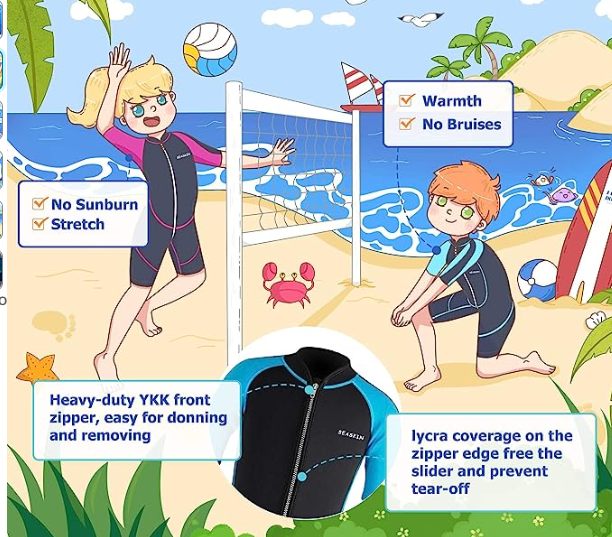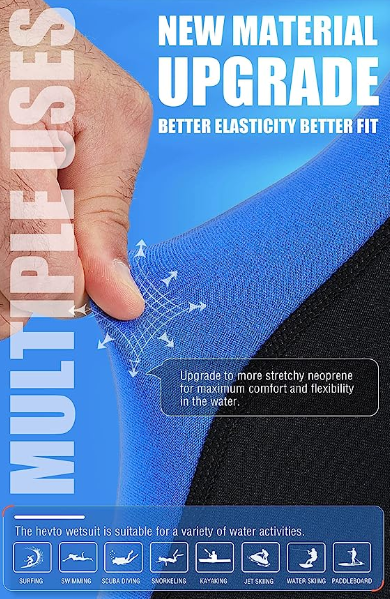Bestway Factory are a professional manufacturer of wetsuit for 16 years.We process for many world famous brands,such as bodyglove,O’Neill and etc.Do you want to know what kind of wetsuit are suitable for your children and yourself?
How to choose a wetsuit for children?
When choosing a wetsuit for children, there are several factors to consider to ensure a proper fit and maximum comfort. Here are some steps to help you choose a suitable wetsuit for your child:
1.Why does your child need to wear a wetsuit? – In cold water, wetsuit can keep the body extra warm. The working principle of diving suits is that when water enters the clothes, and then leaves a thin layer of water on the body. Then the body keeps moving to generate heat, heating and keeping the body warm. At the same time, in open water, you can avoid being injured by marine organisms, and avoiding water pollution causing skin sensitivity. The wetsuits provide your kids a better protection.
2.Determine the purpose: Consider the primary activity for which the wetsuit will be used. Whether it’s such as diving, swimming, surfing, snorkeling, paddle boarding, kiteboarding, wakeboarding, kayaking, sailing and so on, different activities may have specific requirements in terms of thickness, flexibility, and coverage.


3.Assess water temperature: Know the average water temperature in the area where your child will be using the wetsuit. This will determine the thickness of the wetsuit required for adequate insulation. Wetsuits are typically available in various thicknesses, such as 3/2mm, 4/3mm, or 5/4mm, which indicates the thickness of the neoprene material in millimeters.

4.Consider the fit: The wetsuit should fit snugly but not restrict movement. It’s essential to check the sizing chart provided by the manufacturer and measure your child’s height, weight, chest, waist, and hip circumference to choose the appropriate size. Each brand may have slightly different size guidelines, so refer to their specific measurements.


5.Opt for a reputable brand: Choose a wetsuit from a well-known brand that specializes in water sports gear. Trusted brands often provide higher-quality materials and better construction, ensuring durability and improved performance.

6.Check for flexibility: Children need wetsuits that offer flexibility and freedom of movement. Look for wetsuits with stretchy neoprene material and strategically placed stretch panels, especially in areas like the shoulders, arms, and knees, which require a wider range of motion.


7.Consider extra features: Some wetsuits offer additional features like reinforced knees or padding for extra durability, flatlock stitching for improved comfort, or a back zip or front zip entry system for easier wearing. Assess these features based on your child’s needs and preferences.



8.Read customer reviews: Before making a purchase, read reviews from other parents or customers who have bought wetsuits for children. Their experiences and feedback can provide valuable insights into the fit, durability, and overall performance of the wetsuit.


8.Try it on: If possible, have your child try on the wetsuit before purchasing to ensure the proper fit and comfort. Check that the wetsuit covers the body adequately and allows for unrestricted movement.
What to watch out for the first time you wear a wetsuit? – 1) For many kids, full wetsuits can make them feel contracted. This is necessary for them to provide warmth and buoyancy, until your kids get used to it. 2) when you receive a new wetsuit, sometimes you will smell the pungent smell. Please don’t worry, this odor is not harmful to you. We use environmental protection and harmless glue.
Remember, choosing the right wetsuit for your child is important for their safety and enjoyment in the water. A properly fitted wetsuit will keep them warm, protect them from UV rays, and enhance their overall water experience.
How to choose a wetsuit for adult?
Choosing a wetsuit for an adult involves considering several factors to ensure a proper fit and functionality. Here are some steps to help you choose a suitable wetsuit:
- Determine your purpose: Identify the primary activity for which you need the wetsuit. Whether it’s surfing, diving, swimming, or another water sport, different activities may require different wetsuit features.

2.Consider the water temperature: Wetsuits are available in various thicknesses designed to provide insulation in different water temperatures. Warmer waters require thinner suits, while colder waters necessitate thicker suits. Consider the average water temperature you’ll be in to select the appropriate thickness.


3.Understand wetsuit thickness: Wetsuit thickness is typically measured in millimeters (mm) and varies across different parts of the suit. For example, a 3/2mm wetsuit means the torso area is 3mm thick, while the arms and legs are 2mm thick. Thicker suits provide more warmth but may restrict movement, so find a balance that suits your needs.

4.Determine your size: Each wetsuit brand may have slight variations in sizing, so it’s crucial to consult the specific size charts provided by the manufacturer. Typically, you’ll need to measure your height, weight, chest, waist, and hip circumference to find the appropriate size. Ensure the suit fits snugly but allows for comfortable movement.

5.Consider the style and features: Wetsuits come in different styles, including full suits, shorties, spring suits, and more. Choose a style that aligns with your preferences and the water conditions you’ll encounter. Additionally, consider features like zippers (front or back), seams (flatlock or glued and blind stitched), and knee pads for durability and convenience.


Try it on: Whenever possible, try on the wetsuit before purchasing. This allows you to assess the fit and comfort firsthand. Pay attention to how it feels around the neck, arms, and legs, ensuring there are no excessive gaps or tightness.

7.Seek expert advice: If you’re unsure about selecting the right wetsuit, seek guidance from experts at a reputable sporting goods store or consult with experienced individuals in the water sport community. They can provide personalized recommendations based on your specific needs and preferences.
Remember that wetsuits should provide a snug fit to maximize insulation and reduce water flow while allowing you to move comfortably. By considering these factors and trying on different options, you can find a wetsuit that suits your needs and enhances your water activities.
That’s it for this episode. See you next time





